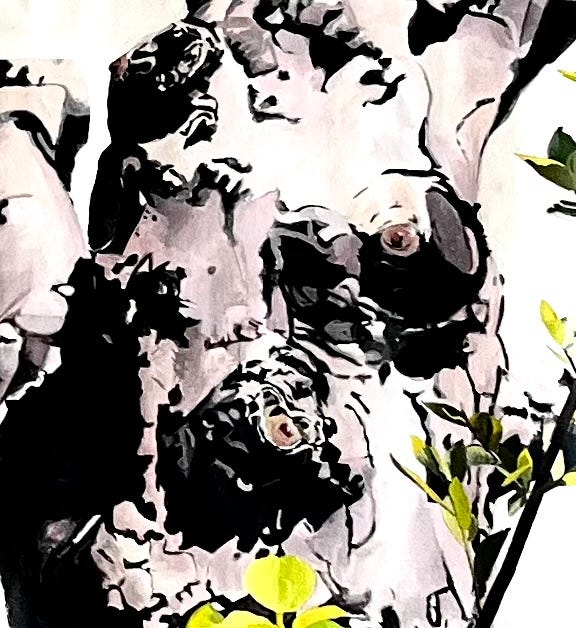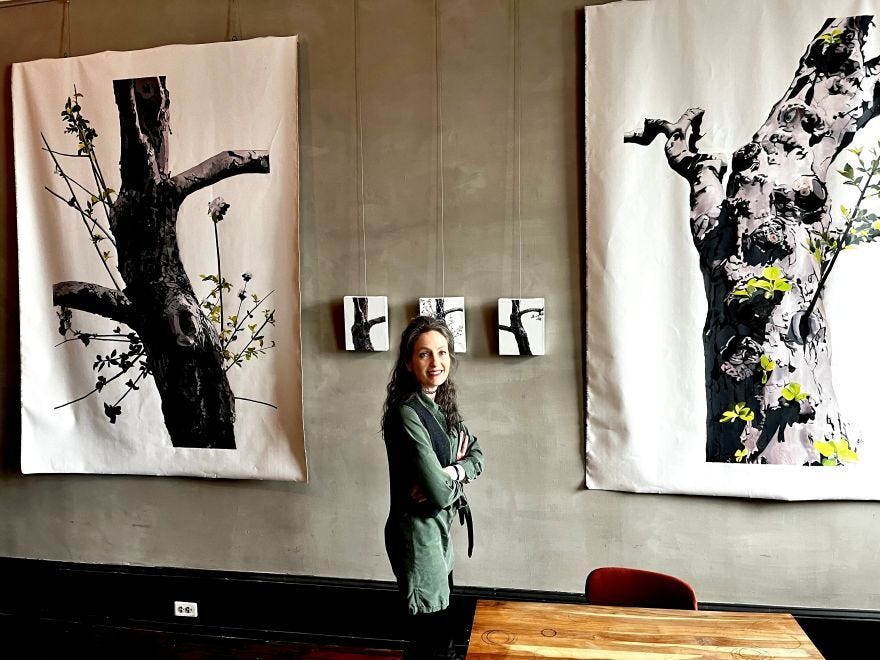Trees with tits
Artist Betsy Jacks is enhancing our appreciation of the natural world in subtly startling ways
A detail from Betsy Jacks’ take on apple trees
Were you a tree — and you may well be, given what I flatter myself are the conservationist tendencies of this enlightened readership — what would be your favorite season? A couple of recent developments in tandem prompted the question. The first, unsurprisingly, was spring, my favorite and I would argue the Northeast’s most exciting time of year. Life feels resurrected. After weeks of cold and little progress a burst of warm weather can bring transformative change to the buds on the maples surrounding our house and the Callery pears lining the driveway.
The other development was a show by artist Betsy Jacks that, alas, closes today at Cafe Joust on Main Street in Catskill, NY. Betsy devotes the solo exhibition to trees, some of them still very much alive, others celebrated in the work of Thomas Cole, widely considered the father of the Hudson River School of painting.
In what might well qualify as a land speed record for second acts Ms. Jacks went from leading the Thomas Cole National Historical Site, stepping down on December 31st from the executive director position that she held for two decades, to her first show as an artist in three short months.
It’s unsurprising that the painter drew her inspiration, in part, from Cole and his passionate promotion of the natural world. Several of the works are based on the powerfully emotive trees that frame some of Cole’s most famous paintings, among them 1836’s After the Storm — The Oxbow. “My crazy theory is that trees are the main character,” Betsy told me when we got together at Cafe Joust last Friday. “So I’m calling them out.”
There’s an unavoidable power and poignancy to the show and not just because it’s obvious that the artist has an affinity for trees and documenting their personalities. And if you disagree with me that trees have personalities, with all due respect, you simply haven’t spent enough time around trees. It’s also because almost two hundred years ago Thomas Cole was decrying the same assault on nature and destruction of the landscape of the Hudson Valley and beyond that we’re bemoaning today.
I don’t know whether that’s reason for encouragement, if only because we’re still here; or sadness because the forces of so-called progress and the fast buck, on the one hand, and preservation, on the other, seem to be at a perennial standoff. The assault on nature feels even more dire and pressing under the Trump administration but perhaps neither side will ever get to declare outright victory. The impulses toward conservation and development, or should I say desecration, are evenly matched.
“He was trying to raise the alarm,” Betsy told me, speaking of Cole, and what he saw as the clear cutting of the Hudson Valley’s first growth forests. “This was going to represent the loss of extraordinary beauty. It affected him very deeply and he wrote a lot about it.” In one of the descriptive panels that accompanies her work, Jacks quotes Cole’s 1838 poem Lament of the Forest. “A few short years! — These valleys, greenly clad, these slumbering mountains, resting in our arms, shall naked glare beneath the scorching sun.”
The artist at Cafe Joust in Catskill, NY
Betsy grew up in New York City but spent summers in Tenants Harbor, the midcoast Maine town where her family had owned a sail making company that went out of business in the 19th century with the advent of the steamship. It’s in Maine with its teeming tidal pools and forests descending to the ocean’s edge, its wetlands and sea roses where she developed an intimate relationship with the natural world. After college she worked as an artist in Williamsburg, Brooklyn and joined the staff of the Whitney Museum.
“I always wanted to get back to this,” she said. “I didn’t know when. Being the cautious type I thought I’d have a day job for the rest of my life.”
But she worked out an arrangement with the Thomas Cole National Historic Site’s board of directors -- she’d spend four days tending to Cole’s legacy and Fridays to painting. The exhibition is really two shows in one. The first are those studies based on Cole’s work. The second are large scale paintings of ancient apple trees, specifically those at Samascott Orchards in Kinderhook, NY.
For a minute I thought I was seeing things when I spotted an eye peering out from one of them. After all, trees, the older the better, are wonderfully expressive, doubling as Rorschach tests that invite the viewer to project his or her own imagination onto gnarled bark and twisted limbs. But I wasn’t imagining it. Betsy also pointed out breasts and nipples. She seems trees as metaphors for female aging and, I suspect, for her own next act.
“I like that the trees are so strong,” she told me. “They’re not useless after a certain age. They keep producing their entire lives.”




Trees, and not mankind, are at the top of the hierarchy on this Earth. Trees own the birthright of this planet. The truth is most of us would rather live next to trees than next to other people.
"And this our life, exempt from public haunt, Finds tongues in trees, books in the running brooks, Sermons in stones, and good in everything."
— As You Like It, Act 2 Scene
Unquestionably the best art review headline ever coined. Thank you Ralph!